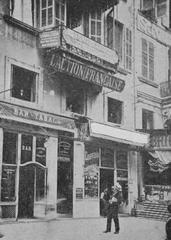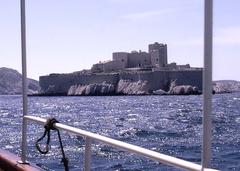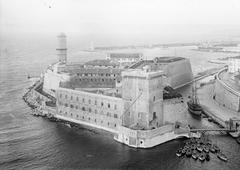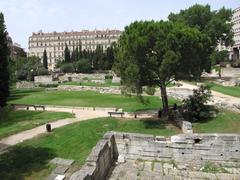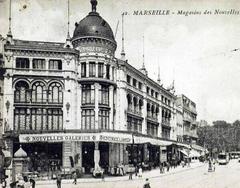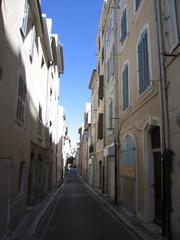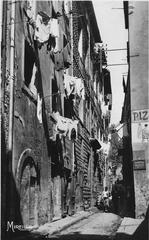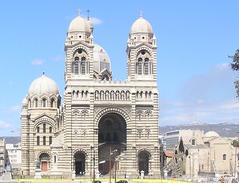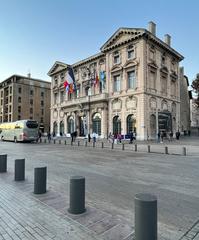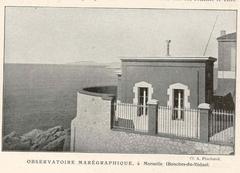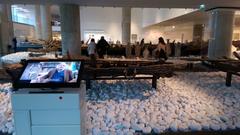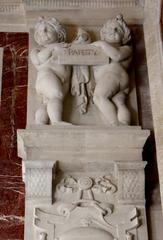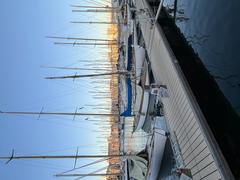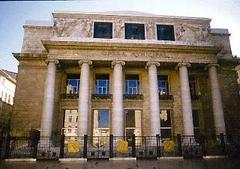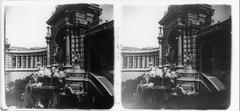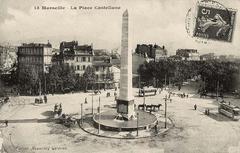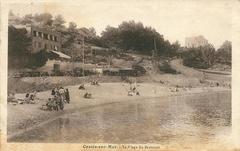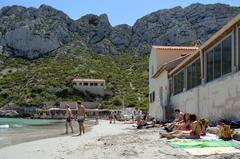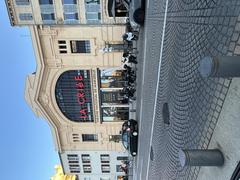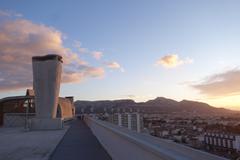Opéra de Marseille: Visiting Hours, Tickets, and Historical Significance
Date: 03/07/2025
Introduction
Nestled near the bustling Vieux-Port, the Opéra de Marseille stands as a vibrant symbol of the city’s rich cultural legacy and dynamic artistic life. As one of France’s most historic opera houses—with origins stretching back to 1685—the Opéra has played a central role in the evolution of Marseille’s social and cultural landscape. From its earliest days in a converted tennis court to its majestic neoclassical and Art Deco incarnations, the Opéra de Marseille reflects centuries of artistic innovation, resilience, and architectural distinction.
This guide offers a comprehensive overview for visitors: covering its fascinating history, architectural highlights, visiting hours, ticketing options, accessibility features, and practical travel tips. It also recommends key nearby attractions, ensuring that every visitor can make the most of their experience in Marseille’s cultural heart.
For the most current information on performances, tours, and special events, always refer to the official Opéra de Marseille website and the Marseille Tourism portal.
Table of Contents
- Introduction
- Historical Overview
- Practical Visitor Information
- Architectural and Artistic Significance
- Visitor Experience
- Travel Tips
- Nearby Attractions
- Community Engagement and Workshops
- Frequently Asked Questions (FAQ)
- Visuals and Media Recommendations
- Conclusion
- References
Historical Overview
Origins and Early Development (17th–18th Centuries)
Marseille’s operatic tradition began in 1685, making it the first city outside Paris to obtain official privilege for opera. Composer Pierre Gautier, with authorization from Jean-Baptiste Lully, inaugurated the first performances in a converted tennis court, setting the stage for centuries of musical excellence (fr.wikipedia.org). Opera quickly became accessible to all social classes, reflecting Marseille’s status as a cosmopolitan port (marseillecityofculture.eu).
The Grand Théâtre de Marseille and 19th Century Expansion
In 1787, the Grand Théâtre de Marseille was inaugurated, boasting a neoclassical façade with Ionic columns and allegorical friezes (marseilletourisme.fr). Throughout the 19th century, the theater became a hub for artistic innovation and civic engagement, hosting premieres of major works and performances by leading artists. Its location near the Vieux-Port anchored it in the city’s cultural life (worldcitytrail.com).
The 1919 Fire and Art Deco Rebirth
A devastating fire in 1919 destroyed much of the Grand Théâtre, sparing only the colonnaded portico and grand foyer (marseille.fr). Reconstruction began in the early 1920s, blending preserved neoclassical elements with striking Art Deco design under architect Gaston Castel. The new opera house, completed in 1924, was celebrated as one of France’s earliest and largest Art Deco public buildings (en.wikipedia.org).
Post-War Era and Modernization
Following World War II, municipal management ensured the Opéra’s continued operation as a public institution. Restoration projects throughout the late 20th century preserved its architectural integrity, with the opera officially recognized as a historical monument in 1997 (marseilletourisme.fr).
The Opéra de Marseille Today
Currently, the Opéra de Marseille boasts a nearly 2,000-seat auditorium and a distinguished ensemble of musicians and vocalists. Its programming balances classic opera, contemporary works, ballet, and symphonic concerts, maintaining its status as a cornerstone of Marseille’s cultural scene (marseilletourisme.fr).
Practical Visitor Information
Visiting Hours
- Box Office: Monday to Saturday, 10:00 AM – 6:00 PM (hours may vary on holidays or special events)
- Performances: Typically start at 7:00 or 8:00 PM, with some weekend matinees.
Check current schedules on the official website.
Ticketing and Pricing
- Where to Buy:
- Official website
- Box office: 3/5 rue Molière, 13001 Marseille
- By phone or mail (details on official site)
- Pricing:
- Standard tickets: ~€15–€100 depending on seat and performance
- Discounts for students, seniors, and groups
- Subscription options (opera, concert, operetta) with up to 30% savings
Accessibility
- Mobility: Wheelchair ramps, elevators, and dedicated seating available
- Hearing/Visual: Select productions offer English surtitles; contact in advance for services
- Facilities: Accessible restrooms, trained staff for assistance
Getting There
- Metro: Vieux-Port–Hôtel de Ville (Line 1)
- Bus: Several lines serve the area
- Parking: Limited nearby; public garages available
- Cycling: Le Vélo bike-sharing stations close by (Marseille City of Culture)
Architectural and Artistic Significance
The Opéra de Marseille harmoniously combines neoclassical and Art Deco styles. Its façade features a colonnaded portico and allegorical reliefs, while the interior showcases an urn-shaped auditorium with geometric Art Deco motifs, a grand staircase, and a monumental chandelier (Marseille Tourism). The foyer is adorned with turquoise Sèvres urns, gilded masks, and Provence-inspired murals, reflecting the city’s maritime heritage.
The auditorium is renowned for its excellent acoustics and unobstructed views, seating nearly 2,000 guests (marvellous-provence.com).
Visitor Experience
Dress Code and Etiquette
Smart casual or formal attire is customary, especially for evening performances. Arrive 30 minutes early for security and seating.
Performance Schedule
The season runs from September through June, featuring a diverse calendar of operas, ballets, and concerts. Performances typically last 2–3 hours, with intermissions (Music & Opera).
Food and Drink
A bar serves drinks and light snacks before performances and during intermissions. The surrounding district offers a range of cafés and restaurants (Wanderlog).
Guided Tours and Workshops
Guided tours reveal the opera’s history, architecture, and backstage areas. Educational workshops and special events are held regularly; check the official website for details.
Travel Tips
- Book Early: Popular performances often sell out.
- Arrival: Latecomers may only be admitted during intermissions.
- Photography: Prohibited during performances; allowed in public spaces without flash.
- Cloakroom: Available for coats and bags; large backpacks may be restricted.
- Families: Family-friendly shows and matinees are scheduled throughout the season.
Nearby Marseille Historical Sites
Enhance your visit by exploring these nearby attractions:
- Vieux-Port: Lively harbor with cafés and markets (PlanetWare)
- Le Panier: Marseille’s oldest district with narrow streets and artisan shops
- Musée d’Histoire de Marseille: Artifacts and exhibits tracing 2,600 years of history
- Basilique Notre-Dame de la Garde: Iconic basilica with panoramic city views
- La Canebière: Historic avenue lined with boutiques and cafés
Community Engagement and Workshops
The Opéra de Marseille offers educational programs, community workshops, and behind-the-scenes tours, fostering a deeper connection to the performing arts (Marseille City of Culture FAQ).
Frequently Asked Questions (FAQ)
Q: What are the visiting hours for the Opéra de Marseille?
A: Box office hours are Monday to Saturday, 10:00 AM to 6:00 PM. Performances usually start at 7:00 or 8:00 PM. Always check the official website for updates.
Q: How do I purchase tickets?
A: Tickets are available online, at the box office, by phone, or mail. Subscriptions and discounts available.
Q: Is the opera accessible for people with disabilities?
A: Yes, with ramps, elevators, dedicated seating, accessible restrooms, and staff assistance.
Q: Are guided tours available?
A: Yes, on select dates and during special events. Reserve through the official website.
Q: What other attractions are nearby?
A: The Vieux-Port, Le Panier, Notre-Dame de la Garde, and the Musée d’Histoire de Marseille are all within walking distance.
Visuals and Media Recommendations
- Images:
- “Opéra de Marseille façade showcasing neoclassical and Art Deco architecture”
- “Interior view of the Art Deco auditorium at Opéra de Marseille”
- Interactive Map:
- Embed a map showing the opera’s location near the Vieux-Port and nearby attractions
- Virtual Tour:
- Link to official video or virtual tour if available
Alt text should include keywords such as “Opéra de Marseille visiting hours,” “Opéra de Marseille tickets,” and “Marseille historical sites” for SEO and accessibility.
Conclusion
The Opéra de Marseille is not just a historic monument; it is a living testament to Marseille’s artistic spirit and cultural evolution. With its unique architectural blend, diverse programming, and central location, it offers an inspiring experience for both new visitors and seasoned opera lovers. Plan your visit today—explore world-class performances, take in the architectural splendor, and immerse yourself in Marseille’s vibrant cultural scene.
For up-to-date information on schedules, tickets, and special events, always consult the official Opéra de Marseille website and the Marseille Tourism portal. Download the Audiala app for seamless ticketing and insider updates, and follow the Opéra on social media to stay connected with Marseille’s operatic tradition.
References
- Opéra de Marseille: Visiting Hours, Tickets, and Historical Overview of Marseille’s Iconic Opera House, 2025
- Opéra de Marseille: Visiting Hours, Tickets, and Cultural Significance of Marseille’s Historic Opera House, 2025
- Opéra de Marseille: Visiting Hours, Tickets, and Architectural Highlights of Marseille’s Historic Opera House, 2025
- Opéra de Marseille: Visiting Hours, Tickets, and Nearby Historical Sites, 2025
- Marseille Tourism, 2025
- World City Trail, 2025
- Wikipedia contributors, Opéra de Marseille, 2025
- Marseille Tourist Office, 2025
- Music & Opera, 2025
